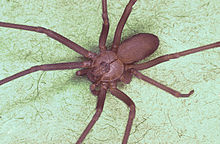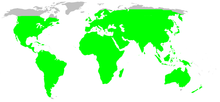Sicariidae
| Sicariidae Temporal range:
| |
|---|---|

| |
| Brown recluse spider (Loxosceles reclusa) | |
| Scientific classification | |
| Domain: | Eukaryota |
| Kingdom: | Animalia |
| Phylum: | Arthropoda |
| Subphylum: | Chelicerata |
| Class: | Arachnida |
| Order: | Araneae |
| Infraorder: | Araneomorphae |
| Superfamily: | Scytodoidea |
| Family: | Sicariidae Keyserling, 1880 |
| Genera | |
| |
| Diversity | |
| 3 genera, 189 species | |

| |
| Synonyms[1] | |
| |
Sicariidae is a
Description
All members have six eyes arranged in three groups of two (dyads). Violin spiders are usually brownish with a darker brown characteristic violin marking on the cephalothorax. They are also
Hexophthalma and Sicarius resemble crab spiders and lack this marking. With the tarantulas, these are some of the longest living spiders, some living up to fifteen years old. Most Loxosceles can live for one and a half to two years.
Venom
All genera are able to produce
The
Taxonomy
The family was first described by Eugen von Keyserling in 1880,[3] and treated as a subfamily and synonym of "Loxoscelidae" in 1893,[7] though this violates the rules of the International Code of Zoological Nomenclature; the publication of Sicariidae in 1880 predates the publication of Loxoscelidae in 1893, and the older name therefore has priority whenever the two are considered to be synonyms. The World Spider Catalog treats Loxoscelinae as a subfamily of Sicariidae,[1] though some sources still recognize Loxoscelidae as a separate family (e.g.,[8][9]).
A phylogenetic study in 2017 showed that the African species of Sicarius were distinct, and placed them in the revived genus Hexophthalma. The relationship found between the genera is shown in the following cladogram:[5]
| Sicariidae |
| ||||||||||||
Genera
As of March 2019[update], the World Spider Catalog accepts the following genera:[1]
- Hexophthalma Karsch, 1879 – Namibia, South Africa
- LoxoscelesHeineken & Lowe, 1832 – South America, North America, Asia, Africa, Central America, Caribbean, Finland, Australia
- Sicarius Walckenaer, 1847 – South America, Central America
See also
References
- ^ a b c d "Family: Sicariidae Keyserling, 1880". World Spider Catalog. Natural History Museum Bern. Retrieved 2019-04-27.
- ^ a b c "Six Eyed Sand Spider". Animal Corner. Retrieved 2019-04-24.
- ^ a b Keyserling, E. (1880). Die Spinnen Amerikas, I. Laterigradae.
- PMID 12781970.
- ^ doi:10.1111/zoj.12442 (inactive 31 January 2024).)
{{cite journal}}: CS1 maint: DOI inactive as of January 2024 (link - PMID 33171968.
- ^ Simon, E. (1893). Histoire naturelle das araignées. p. 271.
- ^ Murphy, J. A.; Roberts, M. J. (2015). Spider families of the world and their spinnerets. British Arachnological Society, York.
- ^ Wunderlich, J. (2004). "Fossil spiders (Araneae) of the superfamily Dysderoidea in Baltic and Dominican amber, with revised family diagnoses". Beiträge zur Araneologie. 3: 633–746.
External links
- "Loxosceles: Recluse spiders". Arachnology Home Pages. Archived from the original on 2003-10-11.
- "Family Sicariidae". Biodiversity Explorer. Archived from the original on 2005-12-07.
- Vetter, R. (2003). "Causes of Necrotic Wounds other than Brown Recluse Spider Bites". University of California, Riverside.
- Vetter, R. (2003). "Myth of the Brown Recluse Fact, Fear, and Loathing". University of California, Riverside.
- "Pictures of the Brown Recluse Spider". Archived from the original on 2006-06-15.
